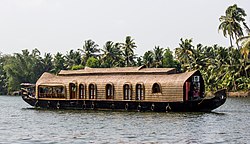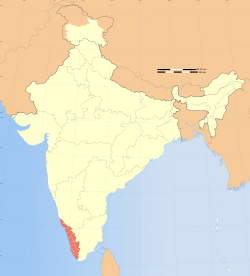Kerala
| Kerala കേരളം | ||
|---|---|---|
| State of India | ||

A houseboat in the Kerala backwaters
| ||
| ||
| Nickname(s): God's Own Country, Spice Garden of India, Land of Coconut Trees | ||
 Location of Kerala (marked in red) in India | ||
 Map of Kerala | ||
| Coordinates (Thiruvananthapuram): 8.5074°N 76.973°ECoordinates: 8.5074°N 76.973°E | ||
| Country | India | |
| Region | South India | |
| Formation | 1 July 1949 | |
| Renamed | 1 November 1956 | |
| Capital | Thiruvananthapuram | |
| Districts | 14 | |
| Government | ||
| • Body | Government of Kerala | |
| • Governor | P. Sathasivam[1] | |
| • Chief Minister | Oommen Chandy(INC) | |
| • Legislature | Unicameral (141*seats) | |
| • Parliamentary constituency | 20 | |
| • High Court | Kerala High CourtKochi | |
| Area | ||
| • Total | 38,863 km2(15,005 sq mi) | |
| Area rank | 22nd | |
| Highest elevation | 2,695 m (8,842 ft) | |
| Lowest elevation | -2.2 m (−7.2 ft) | |
| Population (2011) | ||
| • Total | 33,387,677[2] | |
| • Rank | 13th | |
| • Density | 986/km2(2,550/sq mi) | |
| Demonym(s) | Keralite, Malayali | |
| Time zone | IST (UTC+05:30) | |
| ISO 3166 code | IN-KL | |
| HDI | ||
| HDI rank | 1st (2011) | |
| Literacy | 93.9% (1st) (2011) | |
| Official language | Malayalam, English | |
| Website | Kerala.gov.in | |
Kerala (/ˈkɛrələ/), historically known as Keralam, is a state in South India on the Malabar coast. It was formed on 1 November 1956 following the States Reorganisation Act by combining Malayalam-speaking regions. Spread over 38,863 km2 (15,005 sq mi), it is bordered by Karnataka to the north and northeast, Tamil Nadu to the east and south, and the Lakshadweep Sea to the west. With 33,387,677 inhabitants as per the 2011 Census, Kerala is the thirteenth largest state by population and is divided into 14districts with the capital being Thiruvananthapuram. Malayalam is the most widely spoken and the official language of the state.
The region has been a prominent spice exporter since 3000 BCE. The Chera Dynasty was the first prominent kingdom based in Kerala, though it frequently struggled against attacks by the neighbouring Cholas and Pandyas. In the 15th century, the spice trade attracted Portuguese traders to Kerala, and paved the way for the European colonisation of India. After independence,Travancore and Cochin joined the Republic of India and Travancore-Cochin was given the status of a state in 1949. In 1956, Kerala state was formed by merging Malabar district, Travancore-Cochin (excluding four southern taluks), and the taluk ofKasargod, South Kanara.
Kerala has the lowest positive population growth rate in India; 3.44%, highest Human Development Index (HDI); 0.790 in 2011, the highest literacy rate; 93.91% in the 2011 census, the highest life expectancy; 77 years and the highest sex ratio; 1,084 women per 1000 men. The state has witnessed significant emigration, especially to the Gulf states during the Gulf Boom of the 1970s and early 1980s, and its economy depends significantly on remittances from a large Malayali expatriate community. Hinduism is practised by more than half of the population, followed by Islam and Christianity. The culture is a synthesis of Aryan and Dravidiancultures, developed over millennia, under influences from other parts of India and abroad.
The production of pepper and natural rubber contributes significantly to the total national output. In the agricultural sector,coconut, tea, coffee, cashew and spices are important. The state's coastline extends for 595 kilometres (370 mi), and around 1.1 million people in the state are dependent on the fishery industry which contributes 3% to the state's income. The state has thehighest media exposure in India with newspapers publishing in nine languages, mainly English and Malayalam. Kerala is one of the prominent tourist destinations of India, with backwaters, beaches, Ayurvedic tourism and tropical greenery as its major attractions.




Comments
Post a Comment